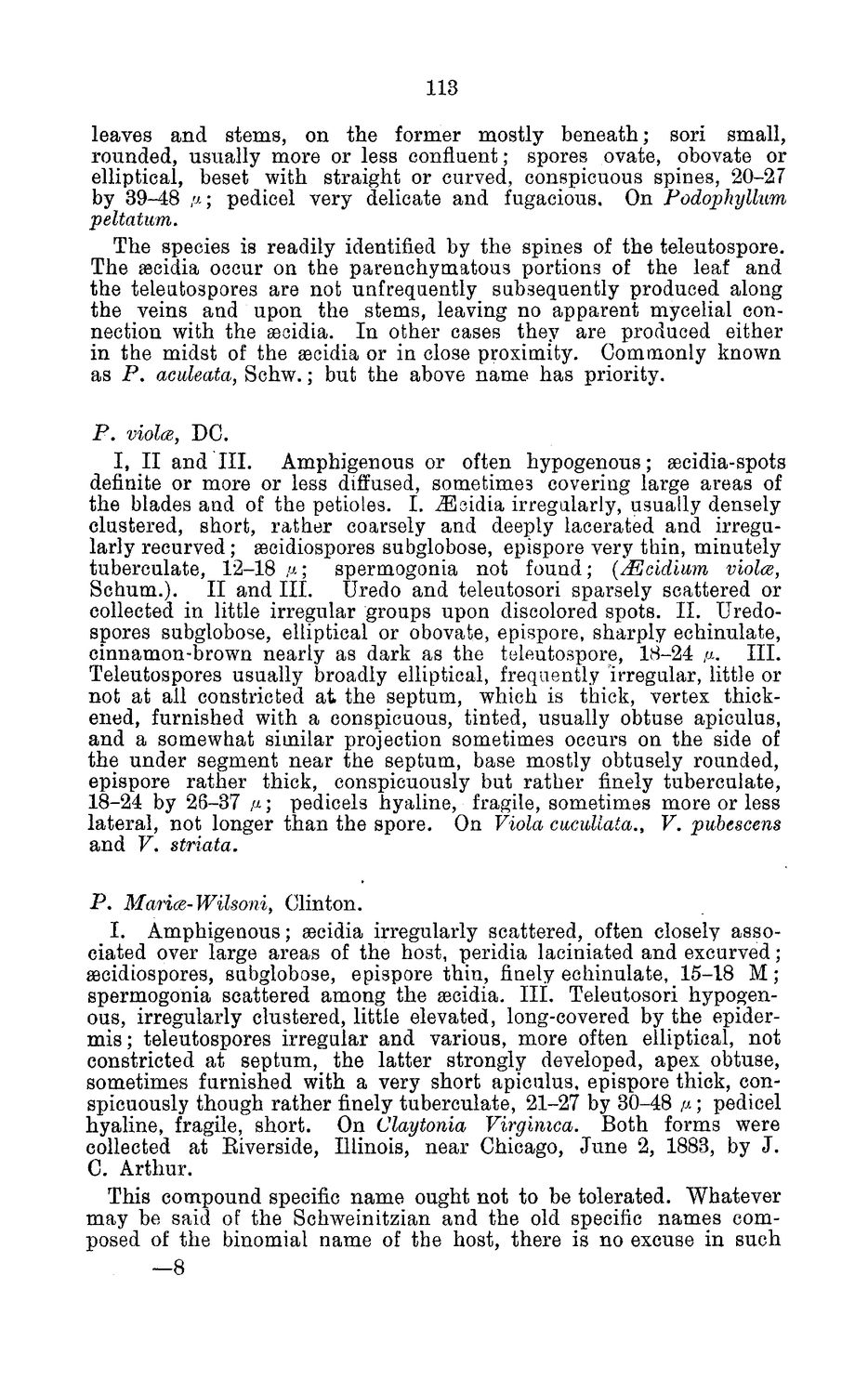| |
| |
Caption: Board of Trustees Minutes - 1884
This is a reduced-resolution page image for fast online browsing.

EXTRACTED TEXT FROM PAGE:
113 leaves and stems, on the former mostly beneath; sori small, rounded, usually more or less conflaent; spores ovate, obovate or elliptical, beset with straight or curved, conspicuous spines, 20-27 by 39-48 n; pedicel very delicate and fugacious. On Podophyllum peltatum. The species is readily identified by the spines of the teleutospore. The SBcidia occur on the parenchymatous portions of the leaf and the teleutospores are not unfrequently subsequently produced along the veins and upon the stems, leaving no apparent mycelial connection with the aeeidia. In other cases they are produced either in the midst of the secidia or in close proximity. Commonly known as P. aculeata, Schw.; but the above name has priority. P. viola, DC. I, II and III. Amphigenous or often hypogenous; secidia-spots definite or more or less diffused, sometimes covering large areas of the blades and of the petioles. I. iEsidia irregularly, usually densely clustered, short, rather coarsely and deeply lacerated and irregularly recurved; secidiospores subglobose, epispore very thin, minutely tuberculate, 12-18 n; spermogonia not found; (Mcidium viola, Schum.). II and III. Uredo and teleutosori sparsely scattered or collected in little irregular groups upon discolored spots. II. Uredospores subglobose, elliptical or obovate, epispore, sharply echinulate, cinnamon-brown nearly as dark as the teleutospore, 18-24 /x. III. Teleutospores usually broadly elliptical, frequently irregular, little or not at all constricted at the septum, which is thick, vertex thickened, furnished with a conspicuous, tinted, usually obtuse apiculus, and a somewhat similar projection sometimes occurs on the side of the under segment near the septum, base mostly obtusely rounded, epispore rather thick, conspicuously but rather finely tuberculate, 18-24 by 26-37 /*; pedicels hyaline, fragile, sometimes more or less lateral, not longer than the spore. On Viola cuculiata., V. pubescens and V. striata. P. Mariae-Wilsoni, Clinton. I. Amphigenous; aeeidia irregularly scattered, often closely associated over large areas of the host, peridia laciniated and excurved; secidiospores, subglobose, epispore thin, fiuely echinulate, 15-18 M ; spermogonia scattered among the aeeidia. III. Teleutosori hypogenous, irregularly clustered, little elevated, long-covered by the epidermis; teleutospores irregular and various, more often elliptical, not constricted at septum, the latter strongly developed, apex obtuse, sometimes furnished with a very short apiculus, epispore thick, conspicuously though rather finely tuberculate, 21-27 by 30-48 j*; pedicel hyaline, fragile, short. On Claytonia Virginica. Both forms were collected at Eiverside, Illinois, near Chicago, June 2, 1883, by J. C. Arthur. This compound specific name ought not to be tolerated. Whatever may be said of the Schweinitzian and the old specific names composed of the binomial name of the host, there is no excuse in such -8
| |